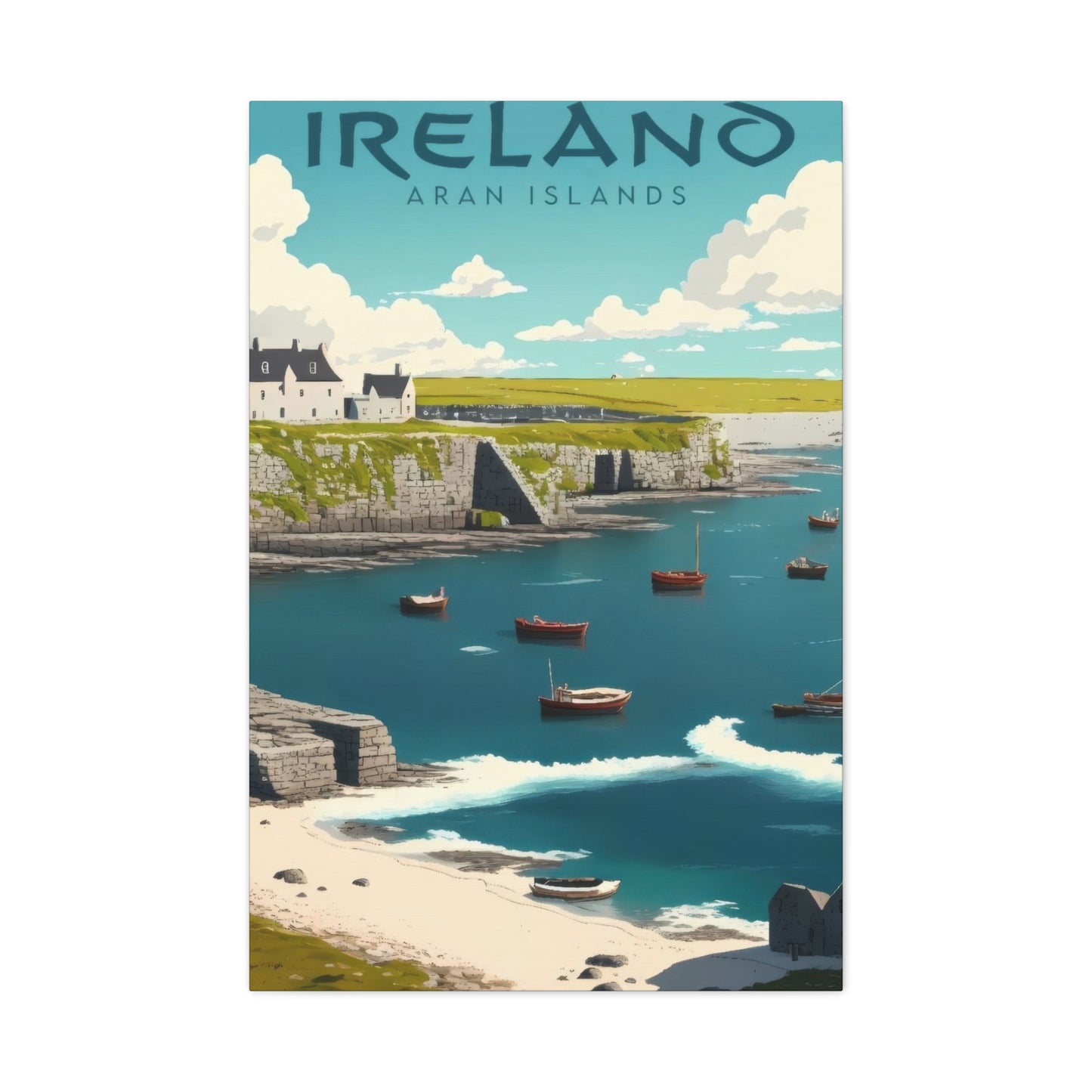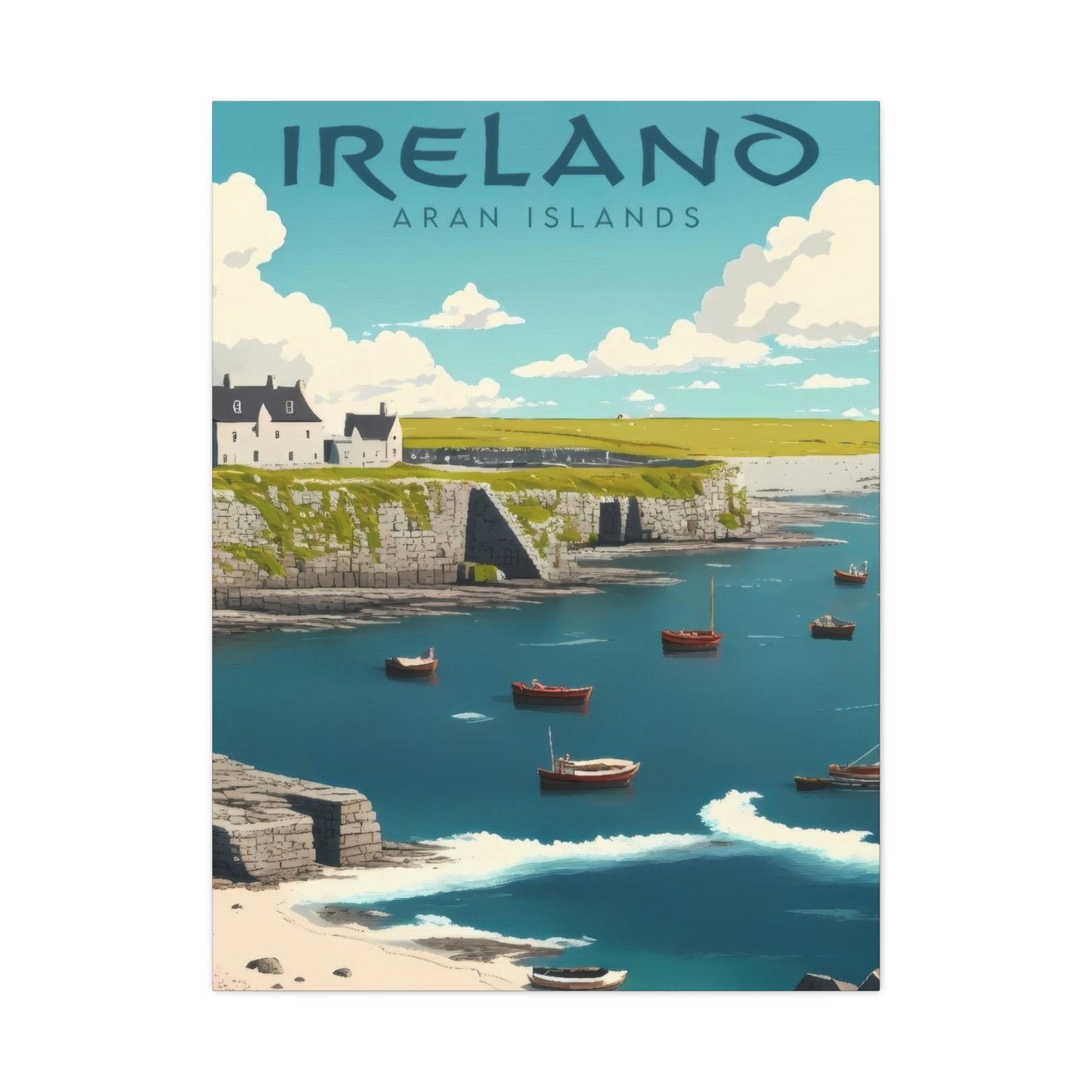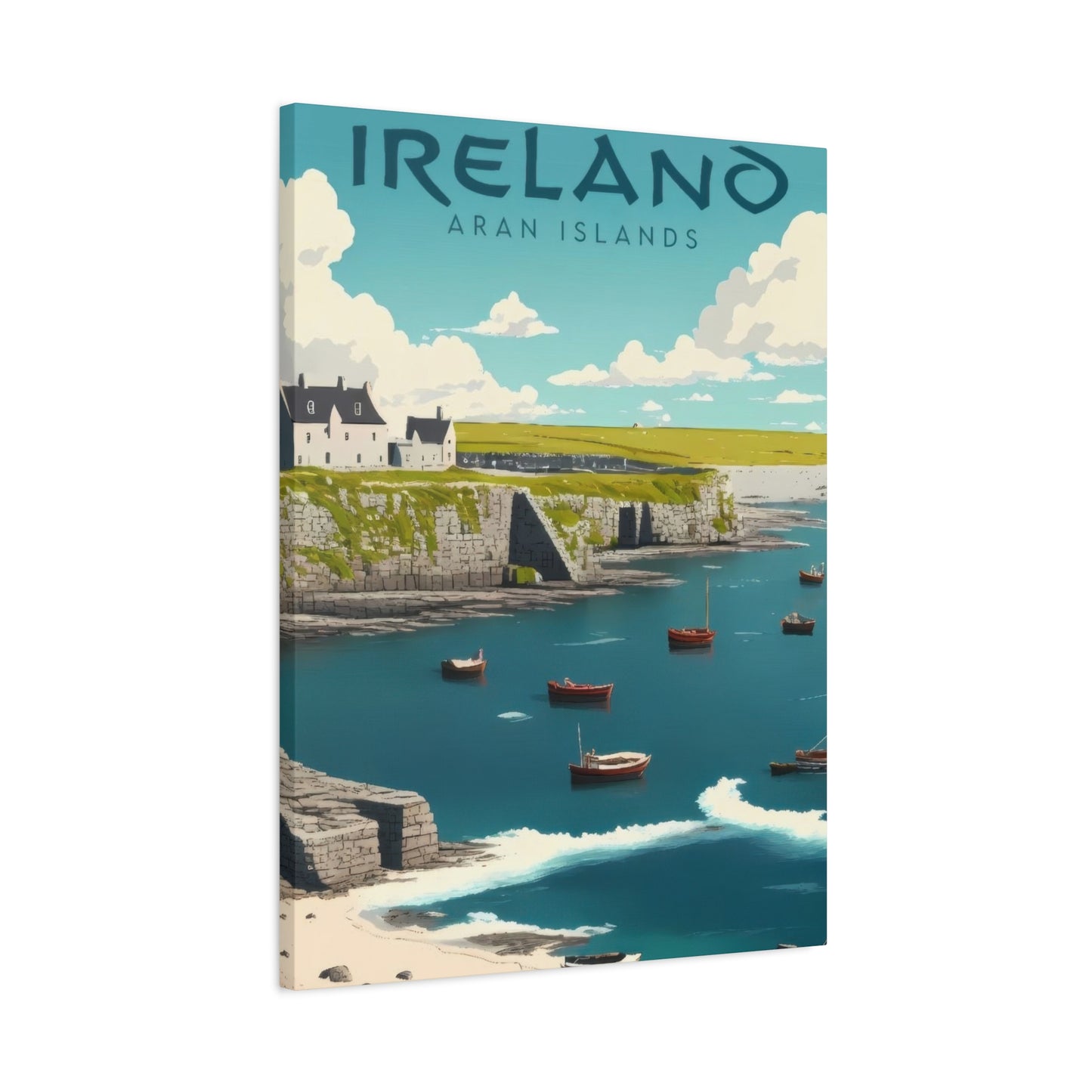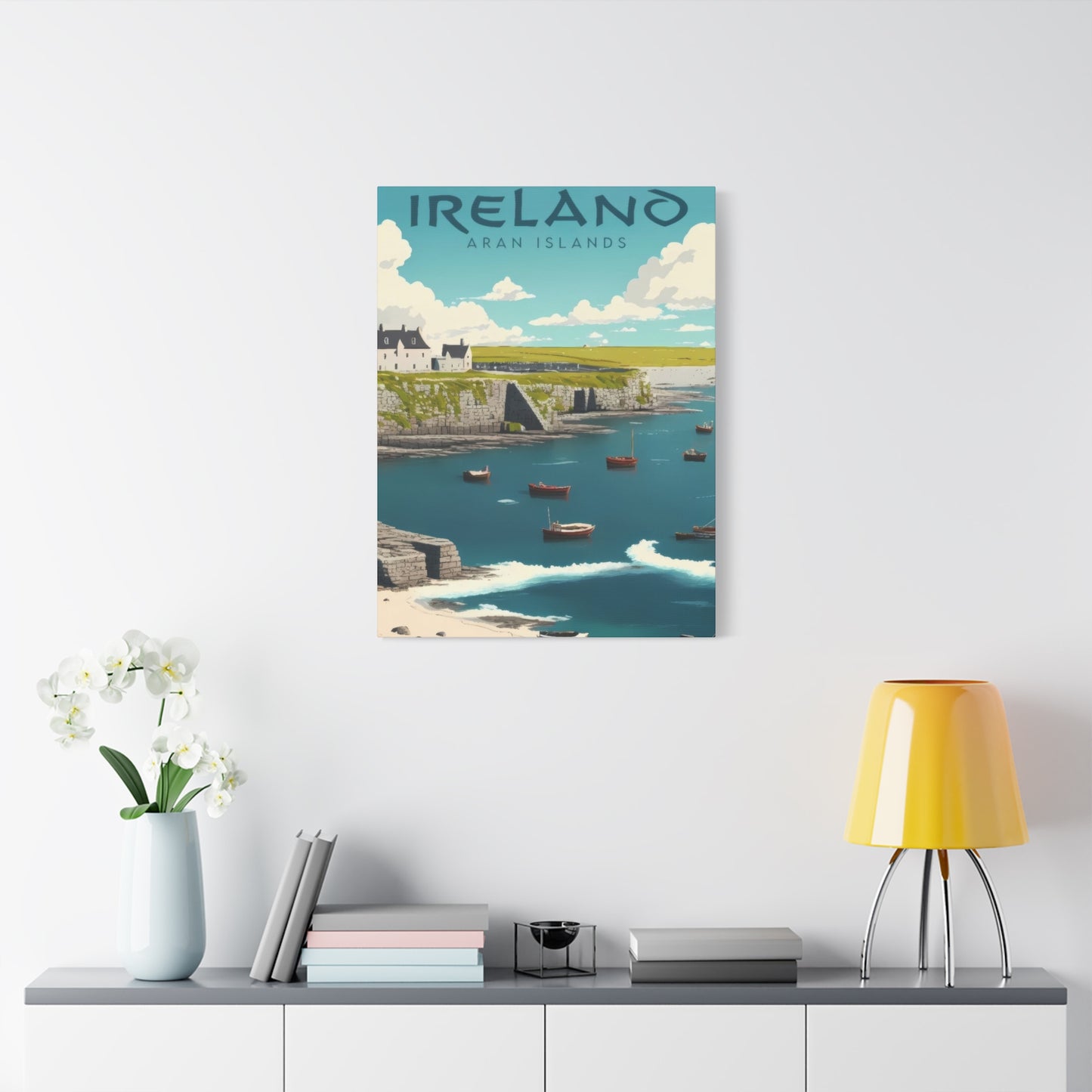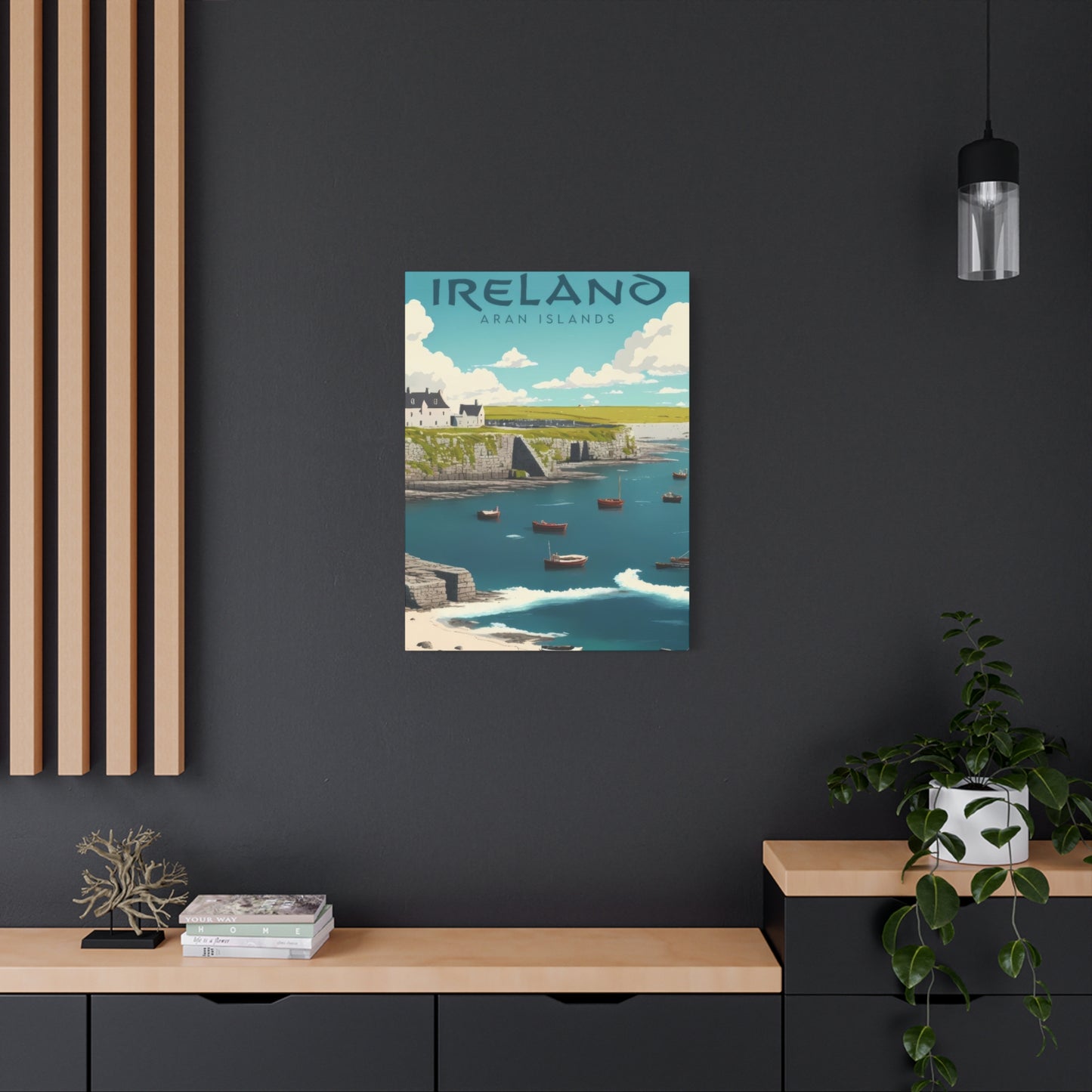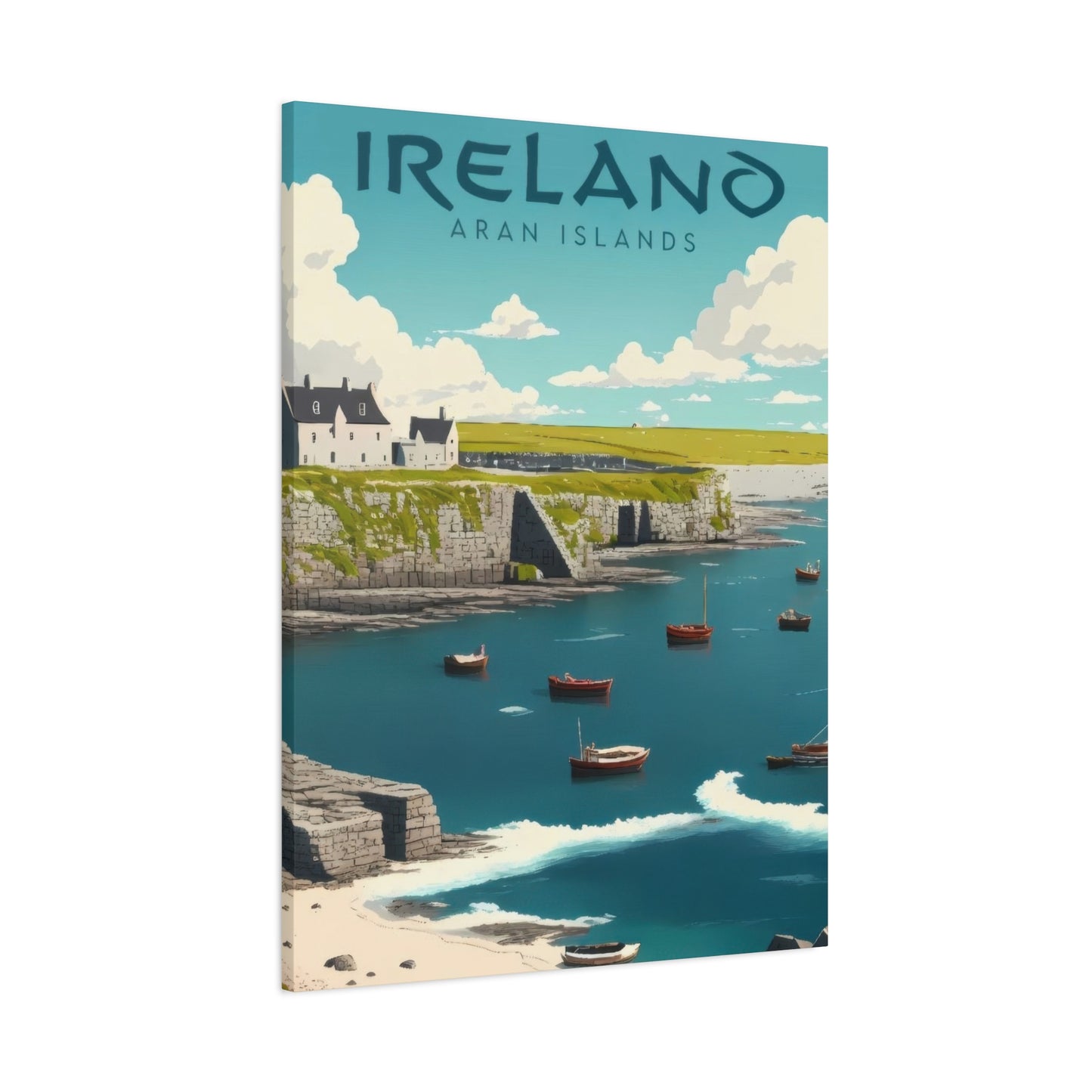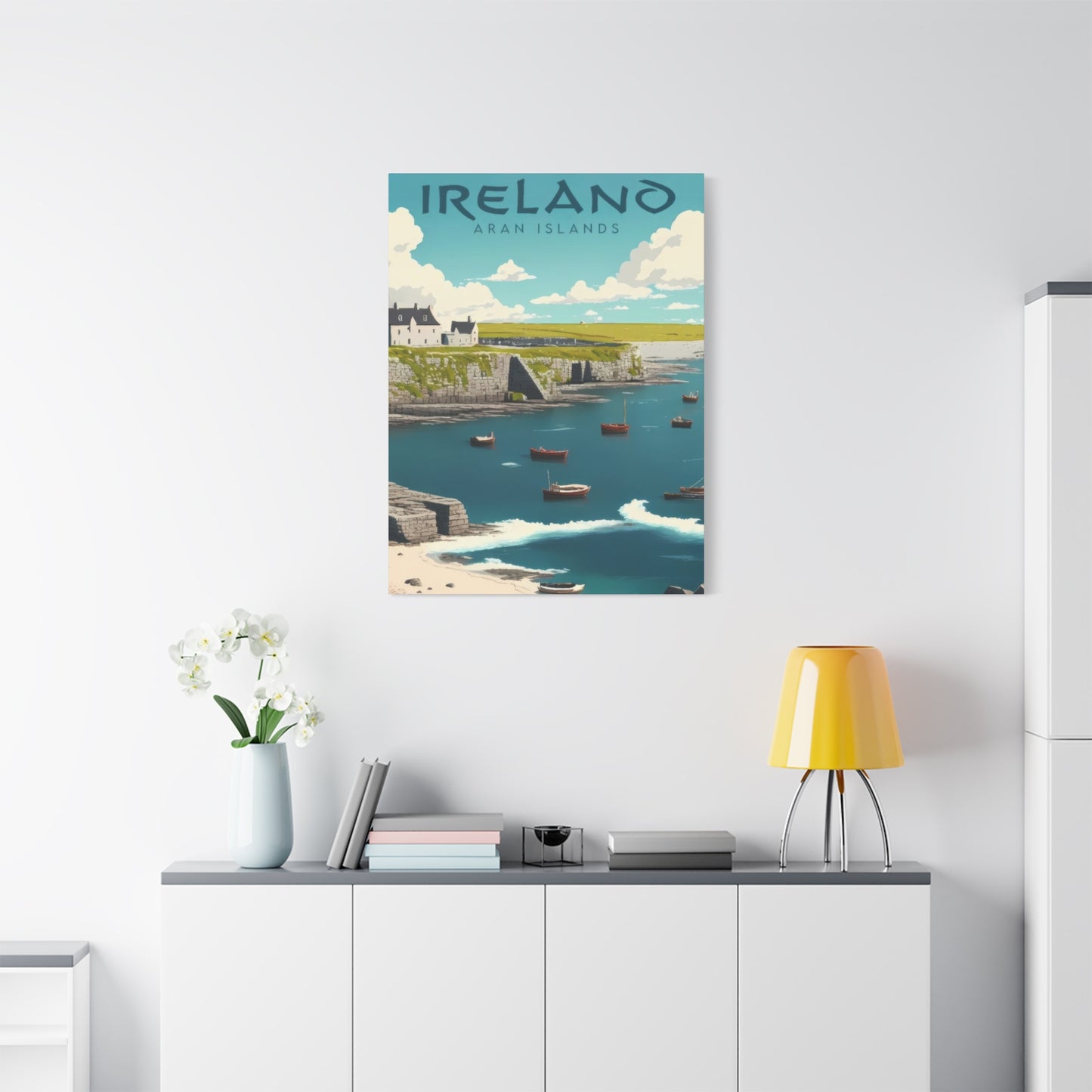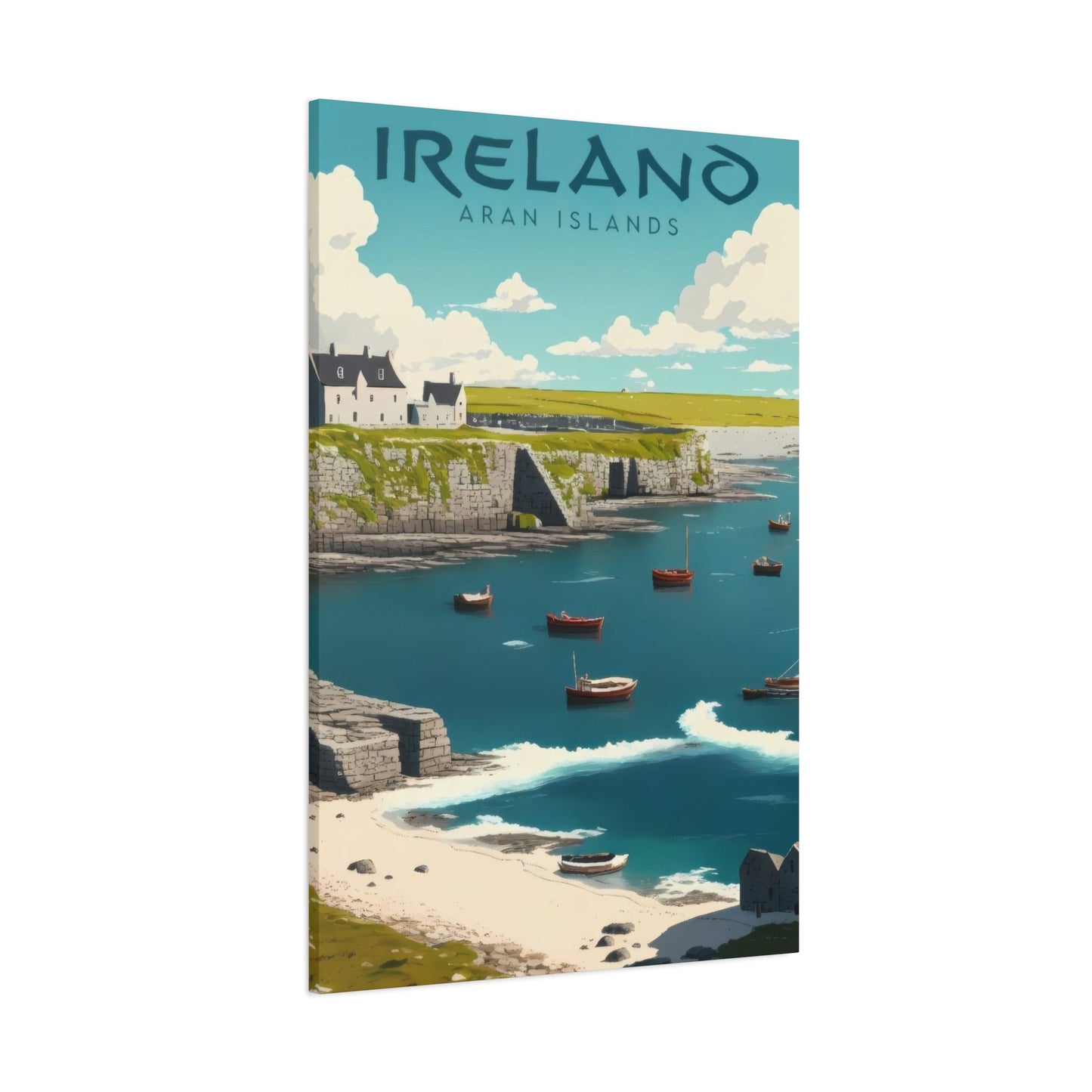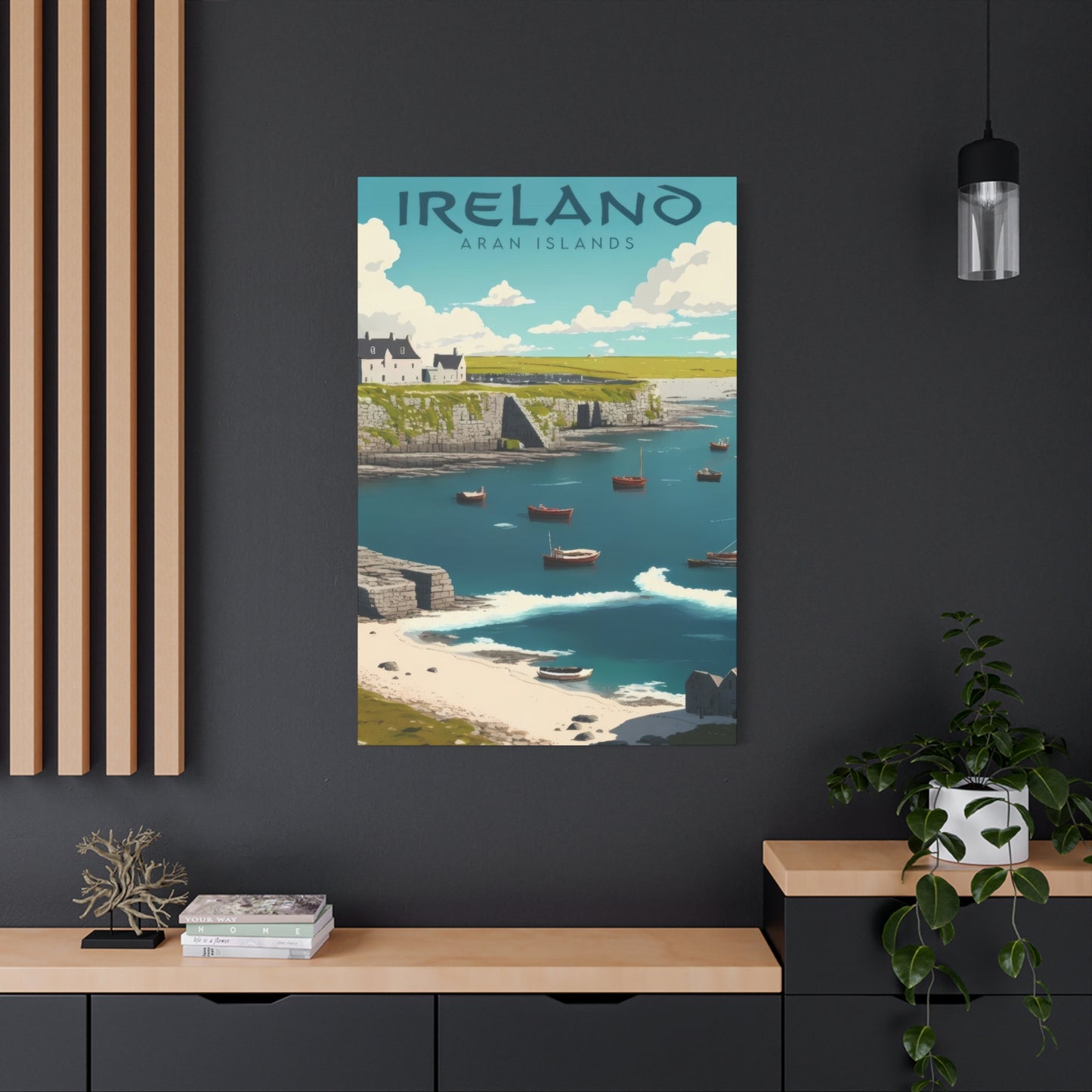A Timeless Connection: How Aran Islands Wall Art Celebrates Ireland’s Heritage and Natural Beauty
The rugged coastline of the Aran Islands represents one of Ireland's most breathtaking natural treasures, where ancient stone walls meet the wild Atlantic Ocean in a dramatic display of nature's raw power and timeless beauty. These remarkable islands, scattered off the western coast of County Galway, have captivated artists, photographers, and travelers for generations with their striking landscapes, traditional Irish culture, and windswept charm. The visual magnificence of this remote archipelago has inspired countless works of art, particularly canvas prints that bring the essence of Irish coastal life into homes and spaces around the world.
Canvas art featuring the Aran Islands offers more than simple decoration; it provides a window into a world where ancient traditions persist, where limestone pavements stretch toward cliff edges, and where the ever-changing moods of the Atlantic create an endless symphony of colors and textures. These artistic representations capture moments frozen in time, preserving the ethereal quality of morning mists rolling across Inishmore's stone forts, the golden light of sunset illuminating the patchwork fields of Inishmaan, and the storm-tossed waves crashing against the rocky shores of Inisheer.
For those who have visited these islands, canvas prints serve as powerful reminders of unforgettable journeys, evoking memories of bicycle rides along narrow roads, conversations with local fishermen, and the profound sense of connection to Ireland's maritime heritage. For those who dream of visiting, these artworks offer inspiration and a tangible connection to one of Europe's most enchanting destinations. The popularity of Aran Islands canvas art reflects a broader appreciation for Celtic landscapes, traditional Irish aesthetics, and the growing desire to incorporate meaningful, culturally rich imagery into modern living spaces.
Irish Coastal Imagery in Modern Interior Design
The incorporation of Irish coastal scenery into contemporary interior design has experienced remarkable growth over recent years, reflecting a broader cultural movement toward nature-inspired decor and meaningful artistic expression. Canvas prints featuring the Aran Islands satisfy multiple design objectives simultaneously, offering visual interest, cultural significance, and emotional resonance that mass-produced generic artwork simply cannot match. These pieces function as focal points in living rooms, create calming atmospheres in bedrooms, and add character to office spaces and commercial environments.
Interior designers increasingly recognize the versatility of coastal Irish imagery, particularly scenes from the Aran Islands, which can complement a wide range of design aesthetics. The neutral color palette found in many Aran Islands photographs and paintings works exceptionally well with minimalist Scandinavian design principles, while the rustic textures and traditional elements appeal to those favoring farmhouse or cottage-style decor. The dramatic seascapes and moody skies captured in storm photography from these islands add sophistication to contemporary urban apartments, creating striking contrasts with modern furnishings and clean architectural lines.
The psychological impact of displaying coastal imagery should not be underestimated. Research in environmental psychology consistently demonstrates that exposure to natural landscapes, particularly coastal scenes, reduces stress levels, improves mood, and enhances overall wellbeing. The Aran Islands, with their expansive horizons, dramatic cloudscapes, and powerful ocean presence, provide particularly effective imagery for creating these beneficial psychological effects. The horizontal lines of the landscape promote feelings of stability and calm, while the dynamic movement captured in wave photography or windswept grass introduces energy and vitality to interior spaces.
Canvas prints offer practical advantages over other artistic mediums when displaying Irish coastal imagery. The texture of canvas adds depth and dimension to photographic and painted images, creating a more engaging visual experience than flat paper prints. The material itself evokes artistic tradition, connecting contemporary prints to centuries of painting history. Canvas withstands environmental conditions better than paper, resisting fading and maintaining color integrity over extended periods when properly cared for. The stretched canvas format eliminates the need for additional framing, though many collectors choose to add floating frames for enhanced presentation and protection.
Selecting appropriate sizes for Aran Islands canvas art requires consideration of both the intended space and the nature of the imagery itself. Panoramic landscapes of the islands work beautifully as large statement pieces, spanning entire walls and creating immersive visual experiences that transport viewers to the windswept Atlantic coast. Smaller individual pieces can be arranged in gallery wall configurations, telling visual stories through multiple perspectives of island life, architecture, and natural beauty. Diptych and triptych formats allow expansive landscapes to be divided across multiple canvases, adding architectural interest while maintaining visual continuity.
The color schemes present in Aran Islands imagery offer remarkable flexibility for interior design applications. The predominant palette includes various shades of grey stone, deep ocean blues and greens, cream and beige tones from limestone and sand, and the occasional burst of color from wildflowers or traditional fishing boats. This naturally harmonious color range coordinates easily with neutral interior schemes while providing sufficient visual interest to anchor and define a space. Seasonal variations captured in different artworks offer opportunities to rotate pieces throughout the year, maintaining fresh perspectives while celebrating the changing moods of the islands.
Stone Walls and Traditional Irish Architecture
The iconic stone walls of the Aran Islands represent one of the most photographed and artistically rendered elements of Irish landscape heritage. These dry-stone constructions, built without mortar from the abundant limestone that characterizes the islands, create an intricate network of field boundaries that has defined the agricultural landscape for thousands of years. The visual patterns created by these walls, particularly when viewed from elevated perspectives or captured in aerial photography, form mesmerizing geometric designs that have inspired countless artists and photographers.
Canvas art featuring the stone walls of the islands captures not merely physical structures but the essence of human adaptation to challenging environments. Each stone placement represents generations of knowledge about wind patterns, drainage, and livestock management. The walls serve multiple practical functions, clearing stones from fields to create arable land, providing shelter for crops and animals from the relentless Atlantic winds, and marking property boundaries in a landscape where natural features are scarce. Their aesthetic appeal derives partly from this perfect marriage of form and function, where practical necessity has created unintentional beauty.
The play of light across stone walls throughout the day creates ever-changing visual dynamics that photographers and painters seek to capture. Morning light emphasizes texture, casting sharp shadows that highlight the individual character of each stone and the skill of the builders who selected and positioned them. Midday sun can wash out some of this detail but creates striking contrasts between the bright limestone and the dark shadows of wall interiors. Evening light bathes the walls in warm golden tones, softening their rugged appearance and creating romantic, nostalgic imagery popular in canvas art. Overcast conditions, common on the islands, produce even, diffused lighting that reveals subtle color variations in the stone and emphasizes the organic patterns of wall construction.
Traditional thatched cottages, though increasingly rare on the islands, appear frequently in canvas art celebrating Aran heritage. These humble dwellings, with their thick walls, small windows, and distinctive thatched roofs secured against Atlantic gales, embody a vernacular architecture perfectly adapted to local conditions. The white-washed walls of these cottages create brilliant focal points in photographs and paintings, contrasting dramatically with darker elements of stone walls, peat stacks, and stormy skies. Many artists capture these structures in various states of preservation, from meticulously maintained heritage buildings to romantically weathered ruins that speak to the passage of time and changing island life.
The juxtaposition of human-built structures with natural landscape elements provides rich compositional opportunities for artists creating Aran Islands canvas art. A single cottage standing against an expansive sky embodies themes of resilience, solitude, and human determination in the face of natural forces. Stone walls leading the viewer's eye through a composition create depth and movement, guiding attention toward distant horizons or significant landscape features. These architectural elements provide scale references that emphasize the vastness of sky and sea, helping viewers comprehend the true magnitude of the Atlantic landscape.
Contemporary canvas art sometimes focuses on abstract interpretations of stone wall patterns, reducing the landscape to essential geometric forms and tonal variations. These modern artistic approaches appeal to collectors seeking artwork that bridges traditional Irish cultural elements with contemporary design sensibilities. The resulting pieces work effectively in minimalist interiors where representational landscape photography might feel too busy or traditional. This artistic evolution demonstrates how the fundamental visual elements of the Aran Islands continue inspiring new creative interpretations across changing aesthetic preferences and design movements.
Atlantic Ocean Seascapes and Maritime Heritage
The Atlantic Ocean dominates the visual and cultural landscape of the Aran Islands, shaping every aspect of life and providing endless inspiration for artistic expression. Canvas art capturing the ocean surrounding these islands ranges from serene, contemplative seascapes showing gentle waves lapping against rocky shores to dramatic storm photography depicting the awesome power of nature unleashed. This variety allows collectors to select pieces matching their emotional preferences and the atmospheric qualities they wish to introduce into their living or working spaces.
Calm ocean scenes from the Aran Islands typically feature crystalline waters revealing the limestone bedrock beneath, creating stunning turquoise and emerald tones that rival tropical destinations. These peaceful seascapes work exceptionally well in bedrooms, bathrooms, and spaces dedicated to relaxation and contemplation. The horizontal emphasis of such compositions promotes feelings of stability and tranquility, while the expansive water surfaces invite meditation and mental spaciousness. Morning photography capturing glassy seas reflecting pastel sunrise colors offers particularly appealing imagery for canvas art, combining the psychological benefits of water imagery with the optimistic associations of dawn light.
Storm photography from the Aran Islands presents entirely different aesthetic and emotional qualities. Massive waves crashing against cliffs, spray thrown high into the air, dark roiling clouds heavy with rain, and seas churned into white-capped fury demonstrate nature's magnificent power. These dramatic seascapes suit spaces where energy, drama, and visual impact are desired, such as office lobbies, dining rooms, or contemporary living areas with high ceilings and bold design elements. The dynamic movement captured in storm photography creates visual excitement, drawing the eye repeatedly back to explore new details and appreciate the photographer's skill in capturing such fleeting, powerful moments.
The maritime heritage of the Aran Islands provides additional subject matter for canvas art, connecting viewers to centuries of seafaring tradition. Traditional currachs, the distinctive black-tarred canvas boats used for fishing and transportation, appear frequently in artistic representations of island life. These vessels, stretched over a wooden frame and remarkably light for their size, exemplify the ingenuity required to survive and prosper in this challenging environment. Canvas art featuring currachs often shows them resting on rocky shores, being rowed through choppy seas, or displayed as cultural artifacts, each presentation offering different narrative possibilities and emotional resonances.
Fishing harbors and piers provide compositional anchors for many Aran Islands seascapes, offering human-scale elements within vast natural environments. The colorful fishing boats moored in small harbors create vibrant accents against the more muted tones of stone, sea, and sky. These working vessels connect contemporary island life to ancient maritime traditions, representing continuity of culture and livelihood across generations. Canvas art featuring harbor scenes often captures the quiet moments between fishing expeditions, when boats rest peacefully and the harbor reflects sky colors in still water, creating mirror images of incredible beauty.
The ever-changing moods of the Atlantic ensure that no two visits to the Aran Islands produce identical photographic opportunities. This natural variability means that canvas art from these islands offers remarkable diversity, even when depicting similar geographical locations. Collectors can assemble series of prints showing the same beach, cliff, or harbor under different weather conditions, lighting situations, and seasonal circumstances, creating gallery walls that celebrate the dynamic nature of coastal environments. This approach to displaying multiple related pieces encourages viewers to consider how perspective, timing, and environmental conditions shape our perception and appreciation of place.
Ancient Monuments and Archaeological Heritage
The Aran Islands host some of Ireland's most significant prehistoric monuments, providing dramatic subjects for canvas art that combines natural beauty with archaeological wonder. Dun Aengus, the spectacular stone fort perched on the cliffs of Inishmore, stands as perhaps the most iconic and frequently depicted archaeological site in western Ireland. This prehistoric fortress, with its concentric stone walls rising to sheer cliff edges hundreds of feet above the Atlantic, creates compositional drama that photographers and painters find irresistible. Canvas art featuring this monument typically emphasizes its precarious clifftop position, the geometric patterns of its defensive walls, or the stunning contrast between ancient human construction and timeless natural forces.
The mysterious origins and purposes of these stone forts continue inspiring speculation and scholarly debate, adding layers of narrative intrigue to artistic representations. Canvas prints depicting Dun Aengus or other ancient monuments invite viewers to contemplate questions about the people who built these structures, their relationships with the landscape, and the continuity of human presence in this challenging environment. This intellectual dimension distinguishes archaeological imagery from purely scenic landscape photography, appealing to collectors interested in history, anthropology, and the deep connections between place and culture.
Smaller archaeological features scattered across the islands provide additional subject matter for canvas art focused on heritage and history. Ancient churches, holy wells, monastic ruins, and standing stones appear throughout the landscape, each with associated legends and historical significance. Artists capturing these elements often emphasize their integration into the natural environment, showing how centuries of wind, rain, and vegetation have softened harsh stone edges and created harmonious relationships between human artifacts and natural processes. This visual narrative of time, persistence, and eventual reconciliation between culture and nature resonates with contemporary audiences increasingly concerned with environmental sustainability and appropriate human relationships with landscape.
The limestone pavement characteristic of the Aran Islands creates otherworldly landscapes that appear almost lunar in certain lighting conditions. These expanses of bare rock, fractured into geometric patterns by natural weathering processes, fascinated geologists, botanists, and artists alike. Canvas art featuring the limestone pavements often adopts close-up perspectives that transform geological formations into abstract compositions of line, texture, and subtle color variation. These pieces appeal to collectors seeking artwork that bridges natural science and aesthetic appreciation, offering visual interest while inviting deeper consideration of geological processes and ecological relationships.
Aerial photography of the Aran Islands reveals patterns invisible from ground level, showing the full extent of field systems, settlement patterns, and the relationship between human activity and natural landscape features. Drone technology has made these elevated perspectives increasingly accessible, resulting in stunning canvas art that presents familiar landscapes from fresh viewpoints. These aerial compositions often emphasize geometric patterns created by stone walls, the organic curves of coastlines, and the patchwork textures of different land uses. The abstract qualities of aerial imagery make these pieces particularly suitable for contemporary interiors, where they function as both landscape representation and geometric design elements.
Canvas art featuring archaeological and historical themes from the Aran Islands serves educational purposes alongside aesthetic functions. These pieces spark conversations, encourage research, and deepen appreciation for Irish cultural heritage. For educational institutions, cultural centers, and businesses promoting Irish heritage or tourism, such artwork communicates values and interests while enhancing interior environments. The combination of visual appeal and cultural significance makes historically themed Aran Islands canvas art particularly valuable for spaces where both aesthetic quality and meaningful content matter.
Seasonal Variations and Weather Dynamics
The Aran Islands experience dramatic seasonal changes that profoundly affect the landscape's appearance and the photographic opportunities available to artists creating canvas prints. Spring brings renewed life to the islands, with wildflowers carpeting limestone pavements and brightening roadside verges. Canvas art from this season often features vibrant purple orchids, yellow bird's-foot trefoil, and blue spring squill creating colorful contrasts against grey stone and green grass. The longer days and increasing light intensity of spring produce clear, bright imagery with saturated colors that energize interior spaces and evoke feelings of renewal and optimism.
Summer on the Aran Islands offers the longest days and most reliable weather conditions, though Atlantic weather remains unpredictable even during peak season. Canvas art from summer months typically shows the islands at their most welcoming and accessible, with tourists visible on beaches, boats in harbors, and outdoor activities in progress. The deep blue skies and intense sunlight of summer create strong shadows and vivid color contrasts that produce dramatic, high-impact imagery suitable for large canvas prints. The lush green of summer vegetation, nourished by frequent Atlantic rainfall, provides rich color saturation that photographs and reproduces beautifully on canvas.
Autumn transforms the Aran Islands into a landscape of golden grasses, ripening berries, and changing light quality as the sun's angle shifts and days shorten. Canvas art from this season often emphasizes warm tones, creating cozy, intimate atmospheres suitable for residential interiors and spaces designed for relaxation and reflection. The autumn light, lower and more golden than summer's harsh brightness, creates romantic imagery with soft shadows and glowing highlights. Storm frequency increases during autumn, providing opportunities for dramatic weather photography that captures the transitional nature of this season, suspended between summer's gentleness and winter's fury.
Winter reveals the Aran Islands at their most austere and challenging, with fierce storms, short days, and landscapes stripped to essential elements of stone, sea, and sky. Canvas art from winter months appeals to collectors appreciating minimalist aesthetics and raw natural power. The muted color palette of winter, dominated by greys, browns, and the white of storm spray and occasional snow, creates sophisticated, contemplative imagery that works beautifully in modern interiors. The dramatic storm photography possible during winter demonstrates nature's full power, with waves towering above cliffs and wind-driven rain reducing visibility to mere meters.
Weather dynamics provide endless variation in photographic conditions on the Aran Islands, even within single days. The rapidly changing Atlantic weather systems create what photographers call dynamic conditions, where sunshine, rain, dramatic clouds, and rainbows might appear within minutes of each other. Canvas art capturing these transitional weather moments often features the most compelling and unusual lighting effects, including storm light, where low-angle sunlight breaks through gaps in dark storm clouds to illuminate landscape features with theatrical intensity. These rare lighting conditions create unforgettable images that command attention and provoke emotional responses from viewers.
Mist and fog, common phenomena on the Aran Islands, create atmospheric conditions beloved by artists seeking ethereal, mysterious imagery. Canvas prints featuring mist-shrouded landscapes reduce visibility and simplify compositions, emphasizing shapes and forms while obscuring details. This atmospheric effect creates sense of mystery and timelessness, removing temporal specificity and allowing viewers to imagine these scenes occurring at any point across centuries of human presence on the islands. The soft, diffused light during misty conditions produces subtle tonal gradations and delicate color relationships that reproduce beautifully on canvas, creating sophisticated artwork suitable for refined interior design schemes.
Flora and Fauna of the Atlantic Coast
The unique ecological conditions of the Aran Islands support specialized plant and animal communities that have adapted to harsh coastal environments characterized by strong winds, salt spray, limited soil, and exposure to Atlantic weather systems. Canvas art celebrating the islands' biodiversity offers collectors opportunities to display nature-focused imagery with specific Irish character and educational value. Botanical photography from the islands showcases remarkable plant species that survive and flourish despite environmental challenges that would defeat less adapted vegetation.
Wildflower photography from the Aran Islands provides colorful, uplifting imagery perfect for creating cheerful, nature-focused interior atmospheres. The bloody cranesbill, with its vibrant magenta flowers, appears frequently in canvas art, often photographed against backgrounds of grey limestone or green grass. The various orchid species found on the islands, including early purple orchids and bee orchids, provide subjects for close-up photography that reveals intricate floral structures and subtle color variations. Spring gentians, rare elsewhere in Ireland but relatively common on the Aran Islands, offer brilliant blue accents that photograph beautifully against neutral stone backgrounds.
The specialized flora of limestone pavements deserves particular attention in canvas art focusing on botanical subjects. These unique plants, adapted to grow in cracks and fissures of bare rock with minimal soil, demonstrate remarkable resilience and adaptation. Maidenhair fern, hart's tongue fern, and various mosses create miniature ecosystems within rock crevices, their delicate foliage providing striking visual contrasts with hard stone surfaces. Macro photography of these plants reveals details invisible to casual observers, creating abstract compositions of texture, pattern, and subtle color that appeal to collectors appreciating both nature and artistic abstraction.
Seabird colonies on the cliffs of the Aran Islands provide dynamic wildlife subjects for canvas art. Puffins, with their colorful beaks and comical expressions, offer particular appeal, though their presence on the islands is seasonal and localized. More common seabirds, including fulmars, kittiwakes, guillemots, and razorbills, nest on cliff faces in dense colonies that create spectacular scenes when thousands of birds wheel through the air simultaneously. Wildlife photography from the islands captures these birds in flight, resting on cliff ledges, feeding their young, or interacting with their environment in ways that reveal behavioral details and ecological relationships.
Marine life visible from the shores of the Aran Islands occasionally features in canvas art, particularly when photographers capture seals basking on rocks or swimming in sheltered bays. These charismatic marine mammals attract significant interest from visitors and provide appealing wildlife subjects that connect viewers to the marine ecosystems surrounding the islands. More rarely, photographers capture cetaceans, including dolphins and occasionally whales, visible from island viewpoints or from boats in surrounding waters. These dramatic wildlife encounters produce memorable images that celebrate the biodiversity of Irish coastal waters.
Livestock, particularly the hardy cattle breeds and sheep that graze island pastures, appear frequently in canvas art depicting Aran agricultural life. These domesticated animals represent the continuation of farming traditions stretching back millennia, their presence connecting contemporary island life to ancient pastoral economies. Photographs of cattle standing among ancient stone walls or sheep grazing near prehistoric monuments create visual narratives linking past and present, natural and cultural elements. The weathered faces of elderly sheep, the patient expressions of cattle, and the lambs gamboling in spring pastures all provide subjects that convey the ongoing relationship between islanders and their working animals.
Photography Techniques for Coastal Landscapes
Creating exceptional canvas art from Aran Islands imagery requires mastery of specific photographic techniques appropriate to coastal landscape environments. The unique challenges presented by Atlantic light, rapidly changing weather, and dramatic landscape features demand both technical knowledge and artistic vision. Photographers working on the islands must balance multiple considerations, including exposure settings, composition principles, timing, and equipment protection, while remaining flexible enough to respond to unexpected opportunities created by shifting conditions.
Exposure management in coastal environments requires particular attention due to the extreme brightness ranges often present in single scenes. The brilliant reflections from water surfaces, bright limestone rock, and white clouds contrast sharply with deep shadows in rock crevices, darker ocean areas, and stormy skies. Many photographers working on the Aran Islands employ graduated neutral density filters to balance sky and land exposures, preventing blown-out highlights in bright areas while maintaining detail in darker regions. Alternatively, exposure bracketing and high dynamic range processing techniques allow photographers to capture multiple exposures at different settings, later combining them to preserve detail throughout the tonal range.
Composition strategies for Aran Islands photography draw on both classical landscape principles and techniques specific to coastal environments. The rule of thirds remains valuable, encouraging photographers to position significant elements like horizons, stone walls, or architectural features along imaginary lines dividing the frame into thirds vertically and horizontally. Leading lines, particularly the stone walls that crisscross the landscape, guide viewer attention through compositions toward focal points or distant horizons. The dramatic cliff edges of the islands provide natural frames and foreground interest that add depth to seascape compositions while emphasizing the vertiginous relationship between land and ocean.
Timing significantly influences the quality of Aran Islands photography intended for canvas reproduction. Golden hour photography, during the first and last hours of sunlight each day, provides warm, directional light that reveals landscape textures and creates long shadows that add drama and dimension to compositions. Blue hour, the period of twilight before sunrise and after sunset, offers softer, more even light with subtle color gradations that suit contemplative, serene imagery. Midday light, while often avoided by landscape photographers elsewhere, can work effectively on the Aran Islands when scattered clouds create dynamic patterns of light and shadow moving across the landscape.
Weather conditions dramatically affect photographic opportunities on the Aran Islands, with storm photography requiring particular skills and appropriate equipment. Protecting cameras from wind-driven rain and salt spray demands weather-sealed equipment, protective covers, and vigilant cleaning routines. The dramatic lighting effects possible during storms, including storm light, rainbows, and unusual cloud formations, reward photographers willing to work in challenging conditions. Post-storm periods often provide exceptional clarity and dramatic skies as weather systems move through, creating ideal conditions for landscape photography that captures the islands' essential character.
Long exposure techniques create distinctive effects in Aran Islands seascape photography, transforming turbulent wave motion into misty smoothness or streaking clouds across skies in ways invisible to human perception. These extended exposures, ranging from several seconds to several minutes, require tripods for camera stability and neutral density filters to prevent overexposure during daylight hours. The resulting images, with their ethereal quality and sense of temporal passage, work exceptionally well as canvas art, creating contemplative, almost meditative imagery that invites extended viewing and reflection.
Canvas Material Quality and Printing Technology
The quality of canvas material and printing technology directly influences the visual impact, longevity, and value of Aran Islands wall art. Contemporary canvas printing technologies have advanced significantly, allowing reproduction of photographs and digital artwork with remarkable color accuracy, detail resolution, and archival stability. Understanding these technical aspects helps collectors make informed decisions when selecting canvas prints for their homes or commercial spaces, ensuring their investment delivers lasting satisfaction and maintains its appearance over years of display.
Professional canvas materials designed specifically for fine art reproduction typically consist of cotton, polyester, or cotton-polyester blends, each offering distinct characteristics. Pure cotton canvas provides the most traditional feel and appearance, with subtle texture variations that enhance the handcrafted aesthetic many collectors appreciate. These natural fiber canvases accept ink beautifully, producing rich colors and deep blacks while maintaining the organic character that distinguishes canvas art from paper prints. Polyester canvases offer superior dimensional stability, resisting warping and sagging even in varying humidity conditions, while their smooth, consistent texture allows extremely fine detail reproduction suitable for high-resolution photography.
The weight and thickness of canvas material affects both the printing quality and the structural integrity of finished pieces. Heavier canvases, typically measured in ounces per square yard, provide more substantial feel and better dimensional stability, particularly for larger prints. Professional-grade canvas materials generally weigh between eight and twelve ounces, with heavier weights preferred for gallery-quality work and substantial installations. The coating applied to canvas surfaces before printing influences ink absorption, color vibrancy, and surface sheen, with options ranging from matte finishes that minimize glare to slight sheens that enhance color depth and visual impact.
Modern giclée printing technology represents the gold standard for reproducing photography and digital artwork on canvas. This inkjet-based process uses archival pigment inks rather than dye-based inks, ensuring color stability and resistance to fading from light exposure and environmental factors. Professional giclée printers employ multiple ink colors, often twelve or more individual pigments, allowing subtle color transitions and accurate reproduction of the wide color gamuts present in well-executed photography. The microscopic ink droplet size achievable with contemporary print heads enables resolution levels exceeding traditional photographic printing, capturing every detail present in high-quality source files.
Color management throughout the printing process ensures that finished canvas prints accurately reproduce the colors captured in original photographs or intended by digital artists. This technical discipline involves calibrating cameras, monitors, and printers to consistent color standards, ensuring that colors displayed on screens during editing closely match the printed results. Professional canvas printing services maintain strict color management protocols, using standardized color profiles and regular calibration procedures to guarantee consistent, predictable results. For Aran Islands imagery, accurate color reproduction ensures that the subtle variations in stone, sea, and sky tones translate faithfully from capture through editing to final canvas presentation.
The stretching and mounting of printed canvas significantly impacts the final presentation quality and longevity of wall art. Gallery-wrapped canvas, where the printed image continues around the sides of wooden stretcher frames, creates clean, contemporary presentations that require no additional framing. This wrapping technique allows the artwork to stand as an independent object, with finished edges on all sides. The stretcher frame construction, typically using kiln-dried wood and carefully designed corner joints, provides stable support that maintains canvas tension over time. Proper stretching technique ensures the canvas surface remains taut and flat without warping or developing wrinkles that would compromise the visual presentation.
Selecting Appropriate Imagery for Different Spaces
Choosing the right Aran Islands canvas art for specific interior spaces requires consideration of multiple factors, including room function, existing decor, lighting conditions, and the emotional atmosphere desired. Different types of imagery serve different spatial and psychological purposes, making thoughtful selection essential for creating harmonious, effective interior environments. The wide variety of available Aran Islands imagery, spanning serene to dramatic, detailed to minimalist, and colorful to monochromatic, ensures appropriate options exist for virtually any interior design challenge.
Living rooms and family gathering spaces benefit from Aran Islands canvas art that encourages conversation and creates welcoming atmospheres. Panoramic landscape views work particularly well in these settings, providing visual interest without overwhelming the space or competing with furniture and inhabitants for attention. Seascapes showing moderate wave action, interesting cloud formations, and balanced compositions create dynamic focal points without the visual aggression of storm photography. Imagery incorporating both natural and cultural elements, such as stone walls leading through pastures toward distant horizons, offers visual complexity that rewards repeated viewing while maintaining accessibility and broad appeal.
Bedroom spaces call for calmer, more contemplative Aran Islands imagery that promotes relaxation and facilitates the psychological transition from daily activity to sleep. Gentle seascapes with soft color palettes, misty landscape photography, and dawn or dusk lighting create appropriate atmospheres for rest and renewal. The horizontal emphasis of landscape composition suits bedroom placement above beds, where artwork should not demand attention but rather provide subtle visual comfort. Imagery featuring smooth water, soft skies, and minimal action or detail allows the mind to quiet and disengage from stimulation, supporting the restorative functions bedrooms should serve.
Office and study environments benefit from Aran Islands canvas art that stimulates thought without distracting from work tasks. Dramatic seascapes and storm photography provide visual energy and demonstrate natural power, creating inspiring atmospheres that encourage ambitious thinking and determined effort. Archaeological imagery connecting to themes of heritage, persistence, and human achievement can reinforce professional values and organizational identity. Abstract interpretations of stone wall patterns or limestone pavements offer visual interest and sophisticated design appeal while avoiding the narrative content that might prove distracting during focused work periods.
Dining spaces provide opportunities for more adventurous Aran Islands imagery selections, as these rooms typically host shorter-duration activities where visual stimulation adds to the experience rather than interfering with tasks. Colorful harbor scenes, lively wave photography, and images capturing the social and cultural life of the islands create engaging visual environments that spark conversation and enhance the communal aspects of shared meals. Larger canvas prints or multi-panel installations work effectively in dining rooms, where wall space often exceeds what is available in more furniture-dense living areas.
Hallways and transitional spaces benefit from series or collections of related Aran Islands images that create visual narratives as people move through them. Multiple smaller canvases showing different perspectives of similar subjects, seasonal variations of the same location, or complementary scenes from different islands create gallery wall installations that transform utilitarian circulation spaces into engaging experiences. These areas also accommodate more experimental imagery, as brief exposure time allows for bolder, more challenging artistic choices that might prove overwhelming if encountered constantly throughout daily life.
Bathroom spaces, often overlooked in interior design planning, provide intimate settings where carefully selected Aran Islands canvas art significantly enhances the environment. Water-related imagery feels naturally appropriate in bathrooms, making seascapes and coastal scenes particularly suitable. The typically smaller scale of bathroom spaces works well with focused compositions, macro photography of natural details, or smaller individual prints that maintain impact without overwhelming limited wall areas. Moisture-resistant canvas treatments and appropriate framing protect artwork in these higher-humidity environments, ensuring longevity despite challenging conditions.
Cultural Significance and Irish Identity
The Aran Islands occupy a unique position in Irish cultural consciousness, representing the preservation of traditional Gaelic culture, language, and lifeways in their most authentic forms. Canvas art featuring these islands thus carries cultural significance extending beyond aesthetic appeal, connecting to broader narratives about Irish identity, cultural preservation, and the relationship between Irish people and their ancestral landscapes. For individuals of Irish descent living abroad, particularly in diaspora communities throughout North America, Australia, and elsewhere, Aran Islands artwork provides tangible connections to heritage and cultural identity.
The Irish language, still spoken as a daily community language on the Aran Islands, represents one aspect of cultural continuity that distinguishes these islands within contemporary Ireland. While canvas art cannot directly convey linguistic heritage, imagery depicting traditional life, architecture, and practices associated with Gaelic culture implicitly references this linguistic distinctiveness. For collectors interested in Celtic cultural preservation, Aran Islands artwork symbolizes broader commitments to maintaining traditional knowledge, customs, and values threatened by modernization and cultural homogenization.
Traditional crafts, particularly the famous Aran sweaters with their distinctive cable patterns, connect the islands to broader narratives of Irish handicraft excellence and adaptation to challenging environmental conditions. While canvas art typically does not directly depict these crafts, imagery showing traditional life and working conditions contextualizes the cultural practices that produced such distinctive material culture. The patterns of stone walls, field systems, and settlement arrangements visible in landscape photography represent another form of cultural expression, encoding generations of accumulated knowledge about sustainable living in marginal environments.
The literary and artistic traditions associated with the Aran Islands add additional layers of cultural significance to contemporary canvas art. Writers and artists including J.M. Synge, Robert Flaherty, and numerous others have drawn inspiration from the islands, creating works that shaped international perceptions of Irish rural life and cultural identity. Modern canvas art engaging with similar themes and subjects participates in these established artistic traditions, creating dialogues across time between contemporary creators and historical predecessors. For culturally literate collectors, these artistic genealogies add intellectual depth and historical resonance to decorative artwork.
The role of the Aran Islands as symbols of authentic, unspoiled Irish identity involves both celebration and critical examination. Tourism and artistic representation have long shaped how the islands are perceived and experienced, raising questions about authenticity, commodification, and the relationships between representation and reality. Thoughtful collectors consider these complexities when selecting and displaying Aran Islands canvas art, recognizing that even seemingly straightforward landscape photography participates in larger cultural processes of identity formation and place-making. This critical awareness enriches appreciation without diminishing aesthetic pleasure or cultural connection.
Religious heritage, manifested in ancient monastic ruins, medieval churches, and ongoing Catholic devotional practices, forms another dimension of cultural significance associated with the Aran Islands. Canvas art depicting religious sites or incorporating Christian imagery connects to Ireland's complex religious history and the central role of Catholic faith in Irish cultural identity. For some collectors, these religious dimensions add spiritual significance to decorative artwork, transforming canvas prints into objects of contemplation and devotion rather than purely aesthetic appreciation. For others, the historical and architectural interest of religious structures provides sufficient justification for their inclusion in secular decorating schemes.
Conservation and Environmental Themes
The Aran Islands exemplify the challenges and opportunities of environmental conservation in fragile coastal ecosystems subjected to increasing pressures from climate change, tourism, and economic development. Canvas art depicting these landscapes can serve environmental advocacy purposes, raising awareness about conservation needs while beautifying interior spaces. The pristine quality of landscapes captured in Aran Islands photography implicitly argues for continued protection, demonstrating the aesthetic and cultural value of preserved natural environments.
Climate change impacts already visible on the Aran Islands include increased storm intensity, coastal erosion, and shifts in plant and animal distributions. While canvas art cannot directly combat these challenges, imagery documenting current landscape conditions creates historical records against which future changes can be measured. Photographers working on the islands today create valuable archives of landscape appearance before anticipated climate impacts accelerate, preserving visual documentation of ecosystems and cultural landscapes threatened by rising seas and changing weather patterns.
Sustainable tourism represents both an economic opportunity and a conservation challenge for the Aran Islands. Well-managed tourism generates income supporting island communities and justifying conservation investments, but excessive visitation threatens the environmental and cultural qualities that attract visitors initially. Canvas art celebrating the islands contributes to tourism marketing while potentially increasing visitation pressures. Thoughtful engagement with this paradox might involve supporting conservation organizations, choosing imagery that respects local communities rather than exploiting them for aesthetic purposes, and acknowledging the complex relationships between appreciation, consumption, and preservation.
The delicate ecosystems of limestone pavements, rare plant communities, and seabird colonies require active management and protection to survive increasing human pressures. Canvas art featuring these ecological elements can serve educational purposes, helping viewers understand the biological significance of seemingly barren limestone landscapes or apparently empty ocean cliffs. Accompanying interpretive information, whether displayed alongside artwork or provided digitally, transforms decorative objects into educational tools that increase environmental literacy and appreciation for biodiversity.
Conclusion
In conclusion, Aran Islands wall art stands as a powerful testament to the enduring connection between Ireland’s cultural heritage and the breathtaking beauty of its landscapes. Through the vibrant and evocative representations of this remote yet captivating region, these artworks celebrate not only the physical splendor of the islands but also the deep-rooted history, traditions, and stories that have shaped them for centuries. From the rugged cliffs and serene shores to the distinctive stone walls that define the islands' rural landscape, the art forms associated with the Aran Islands encapsulate a unique and timeless identity that resonates with both locals and visitors alike.
One of the most striking elements of Aran Islands wall art is its ability to convey the islands' natural beauty in a way that feels both personal and universal. Artists often use the dramatic contrasts between land and sea, as well as the weathered textures of stone, to create works that evoke a deep sense of place. Whether it’s a painting capturing the vivid hues of an Aran sunset, a photograph highlighting the intricate patterns of ancient stone walls, or a sculpture that mirrors the stoic endurance of the island’s inhabitants, these artworks act as visual storytellers, narrating the story of the Aran Islands in an intimate and poignant way.
The natural beauty of the islands is undeniably a central theme, but so too is the islanders’ profound relationship with the land. The Aran Islands have been inhabited for thousands of years, and this long-standing connection to the land is reflected in the enduring symbols that appear in the artwork. The stone walls, for example, which divide the landscape into small, manageable plots, are not just physical markers of territory but also cultural symbols of the ingenuity and resilience of the island's people. Wall art depicting these stone structures speaks to the islanders' resourcefulness, their ability to craft shelter and sustenance from a rugged and often harsh environment.
Beyond the natural environment, the heritage of the Aran Islands is intricately woven into the fabric of these artworks. The islands are home to a rich cultural legacy that includes ancient Irish language, folklore, music, and traditional crafts. Artists often draw upon these cultural threads, infusing their work with symbols and motifs that evoke the mystical spirit of the islands. The presence of Celtic imagery, for example, or the incorporation of traditional Irish patterns, serves as a reminder of the islands’ place in the broader context of Ireland’s history. Furthermore, the role of the Aran Islands in Irish literature and its significance as a hub of intellectual and cultural life are frequently referenced in visual art, allowing viewers to appreciate the islands not just for their physical beauty but for their cultural and historical significance.
The impact of Aran Islands wall art extends far beyond the shores of the islands themselves. As these works are displayed in homes, galleries, and cultural institutions around the world, they offer a window into the soul of Ireland. The island’s remote and somewhat mystical atmosphere has long captured the imaginations of people across the globe, and this is reflected in the widespread appeal of Aran Islands wall art. These artworks have the power to transport viewers to another time and place, creating an emotional connection that transcends geographical and cultural boundaries.
Moreover, Aran Islands wall art serves as a form of cultural preservation. In an era where globalized influences are increasingly homogenizing the world, these artworks provide a vital link to a way of life that is slowly fading. The traditions of fishing, farming, and weaving that once sustained the island communities have evolved, but the artworks preserve the memory of these practices, keeping them alive for future generations. The art acts as both a record and a tribute to a lifestyle that was deeply connected to the land and the sea.
In essence, Aran Islands wall art is more than just decoration; it is a celebration of the enduring relationship between nature, culture, and identity. It captures the essence of a place that has shaped its people and continues to inspire those who are fortunate enough to encounter it. Through its rich blend of visual beauty, cultural symbolism, and historical depth, it reminds us all of the importance of preserving and cherishing the landscapes and traditions that form the bedrock of our collective heritage. In doing so, Aran Islands wall art ensures that this timeless connection between people and place will continue to resonate, not only within the boundaries of the islands but across the globe.


















